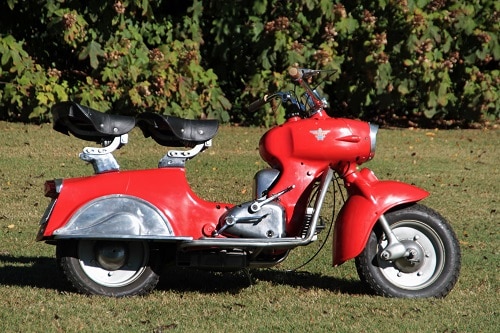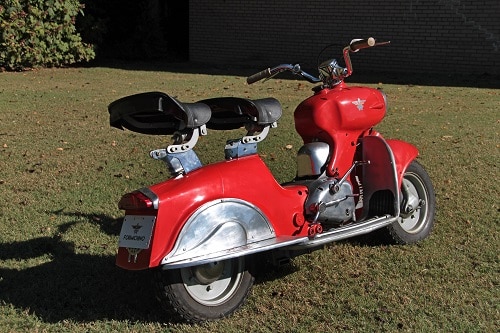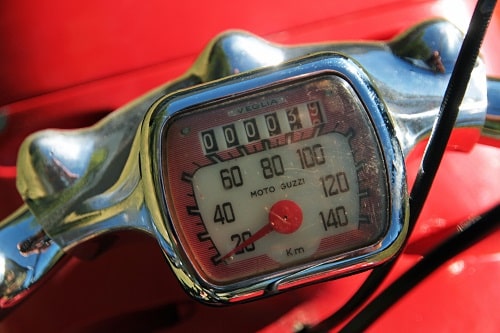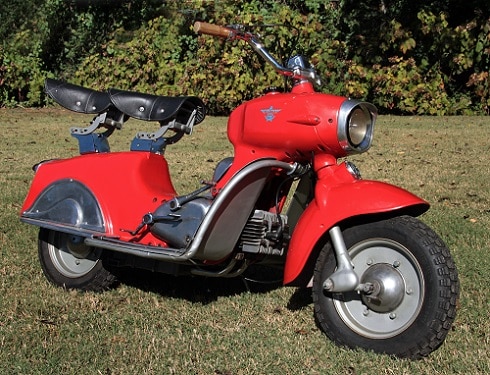
Rumi Formichino- 1955
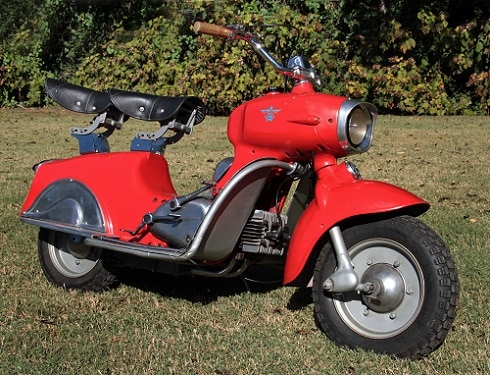
Fonderie Officine Rumi (F.O.R.) was founded in 1906 in Bergamo, Italy by Achille Rumi. They originally supplied cast components for the textile machinery. During the Second World War, Rumi engaged in a totally different engineering role—as a constructor of midget two-man submarines, propellers, and periscopes, elements represented in their badge. Achille’s son, Donnino was a classically trained artist with a passion for painting, drawing and sculpture. He took over the family business in the 1920s, and worked there full-time until the company shut down in 1962. At the end of WW2, under Donnino’s direction, production was switched to manufacturing motorcycles and relaunched the company as Moto Rumi.
Donnino Rumi brought his talents to engineering through design and styling. He made all the drawings and then sculpted them in clay before casting full-scale prototypes in cast iron and aluminum. Italian engineer Pietro Vassena designed an exceptional 125cc parallel-twin two-stroke, the cylinders of which were inclined. This engine design would become Rumi’s trademark engine. The first vehicle, a motorcycle called the Rumi Turismo, was introduced at the Milan show in early 1950 to some acclaim. The Scoiattolo or “squirrel” scooter was introduced the following year.
Rumi’s next scooter model, the Formichino, or “little ant” seen here came out in 1954. It is a beautiful sculptural piece. Most European scooters of the period are made of steel stampings which often act as a structural frame. With Rumi’s industrial expertise in aluminum casting, the parallel twin engine is an actual stressed member of a cast aluminum monocoque body made in three main pieces. Other scooters of the time consistently hid their engines behind sheetmetal cowls but the Formichino’s attractive aluminum engine cases were proudly on display between the rider’s feet. Beauty aside, the lightweight material also gave a decided performance advantage over the conventional steel-framed Vespas and Lambrettas on Italy’s roads. Both functional and fast, in 1957, 1958, and1960 Rumi won the famous Bol d’Or 24-hour races at Montlhery in France, and subsequently Rumi produced the Bol d’Or scooter named after the race.
Moto Rumi ceased bike production in 1960, and closed the foundry in 1962. Donnino returned to his first loves, painting and sculpture, until his death in 1980. Donnino’s grandson, Stefano, established Rumi Sport Race Engineering in 2009, and has developed both 125cc and 250cc racing motorcycles with some success.
Specifications:
Manufacturer: Moto Rumi SpA
Country of Origin: Italy
Drivetrain Configuration: Mid-engine, monocoque, rear drive
Engine: Air-cooled two-stroke, parallel horizontal twin, 125cc, 6.5HP
Transmission: 4-speed, wet clutch
Weight: 100kg/220lb
Top Speed: 75 km/h (47 MPH)
Years of Production: 1950-1962
Number Produced: Unknown
Cost: 138,000 lire ($226 USD)

